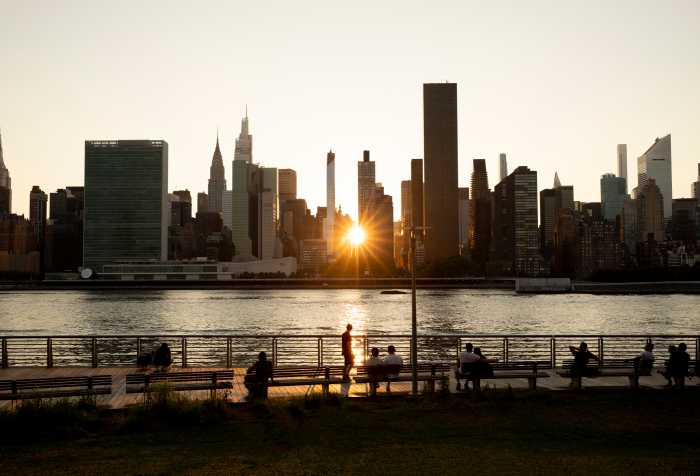
Preservation advocates hope to get landmark protection for 67 Vestry St.
BY SAM SPOKONY | Fearing the demolition of their 118-year-old building as a developer now seeks to replace it, residents of 67 Vestry St. in Tribeca have mounted an effort to protect the site by calling on the city to landmark it.
Developer Aby Rosen, who bought the nine-story building in 2005, filed plans in February to construct a new 11-story, 42-unit building on the site, which is located at the corner of Vestry and West Sts. And since it lies — by mere feet — outside the bounds of the Tribeca North Historic District, which was designated in 1992, it’s unlikely that the city would prevent the building from being demolished under current circumstances.
But residents of the building, aside from their strong personal attachments, believe there is a solid case for it to be named a landmark, due to its pre-1900 historical and architectural significance, as well as the role it later played during the 1970s as a keystone of the Tribeca arts community.
“It would be a loss for everyone, not just us, because we’re all affected when a part of the fabric of our city is lost,” said Jaime Vinas, who has lived at 67 Vestry St. for the past 20 years.
The 1896 building was originally seven stories tall, and was designed by noted architect Frederick P. Dinkelberg, who would go on, several years later, to aid Chicago’s Daniel Burnham in designing the iconic — and landmarked — Flatiron Building, according to a researched report recently compiled by Tribeca Trust, a preservationist group which is backing the residents.
For years, the building served as one of the first warehouses for the Great Atlantic and Pacific Tea Company (which is now commonly known as the A&P). And although that element of the building’s history may not be widely known, the significance of such early A&P warehouses seems to be generally accepted by many experts. A similar warehouse located in Jersey City, N.J. — which was built in 1900, four years after the one at Vestry St. — was named a U.S. National Historic Landmark in 1978, along with being placed on both the New Jersey and National Registers of Historic Places.
The final two stories were added to the top of the building in 1910, according to the Tribeca Trust report, and were designed by another noted architect, Frank J. Helme, who also designed Brooklyn’s Tracy Mansion, which lies within what is now the Park Slope Historic District.
Later, in the 1960s and ‘70s, the Vestry St. building began to comprise artist lofts as the arts community blossomed within Tribeca, and it later gained a legal certificate of occupancy for residential use in 1977, according to city records. During that period of time, those moving into the building included famed sculptor Marisol Escobar and multi-disciplinary artist Robert Wilson, who famously directed the composer Philip Glass’ 1976 opera “Einstein on the Beach.” (After living there for 34 years, Wilson was controversially evicted from his loft by Aby Rosen in 2007, two years after the developer bought the building and began drawing up his potential plans for it.)
Ironically, in addition to his work as a developer, Rosen is also currently the chair of the New York State Council on the Arts, after being appointed to by Governor Andrew Cuomo. In fact, Rosen’s bio on the N.Y.S.C.A. website states he was given the position partially because of his “commitment to the preservation and restoration of landmark buildings.”
There are still a number of artists living at 67 Vestry St. today, and they maintain strong ties to that element of the building’s history.
“I’m just so proud to live here,” said Paul Pagk, a visual artist who moved into the building in 1988, when he was 26 years old. “And the idea of protecting this place is, in many ways, about recognizing those who helped make this neighborhood great, who created a community that helped start the Tribeca arts renaissance.”
He and many of his fellow residents believe that losing 67 Vestry St. would just be another step toward forgetting the character of that past era, and trading it for the “generic” atmosphere of today’s high-end development. And the artists in particular have very personal connections to their studio spaces within the building, where they have painted or sculpted for so long.
“If I were to see this place demolished, it would be like seeing 25 years of my life demolished,” said Pagk.
Jacqueline Miro, an architect and urbanist (as well as a longtime 67 Vestry St. resident) who has worked on renovations at a number of buildings within Tribeca’s landmarked districts, also told Downtown Express that she believes 67 Vestry St. is “equal to, if not superior” to any of the neighborhood’s already-protected buildings.
So now, residents and Tribeca Trust have joined forces to spread their message — and effectively build support — through numerous outlets, on their way to attempting to convince the city’s Landmarks Preservation Commission to protect their building.
The Trust on March 8 started an online petition that calls for landmarking the building, gaining 1,426 signatures by press time. The residents have created a website — weare67vestry.com — to promote the cause, as well as a Facebook group also titled “Weare67Vestry.”
As a result of those efforts, they have also gained a resolution of support from Community Board 1, approved at the March 25 full board meeting, which called on L.P.C. to either individually landmark the building or include it in the North Tribeca Historic District.
Meanwhile, Tribeca Trust has submitted formal application to L.P.C. — a Request for Evaluation, or R.F.E. — which the commission will have to consider to see if they believe the site is worth protecting with landmark status.
That R.F.E. is currently being reviewed, an L.P.C. spokesperson said.
Landmarks is currently headed by Robert Tierney, a Bloomberg appointee, although Mayor de Blasio is reportedly close to appointing a new chairperson.
Rosen’s development firm did not respond to a request for comment.






































